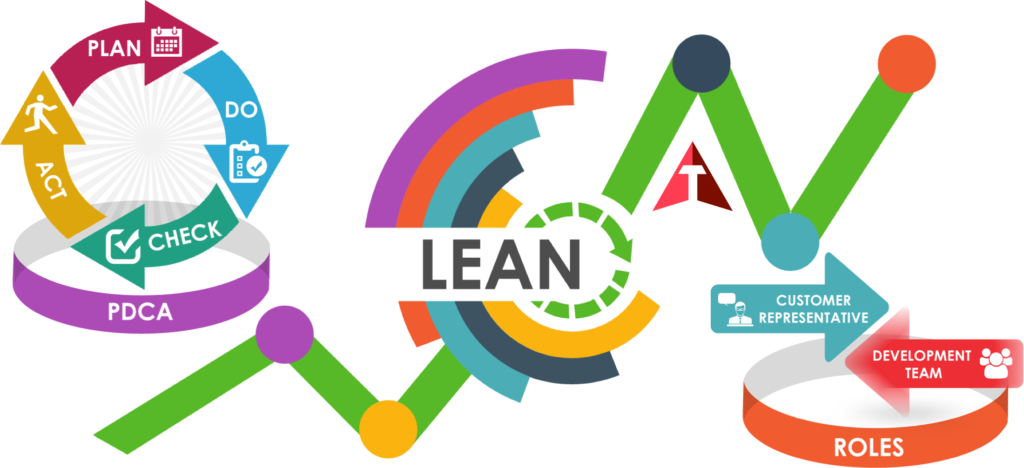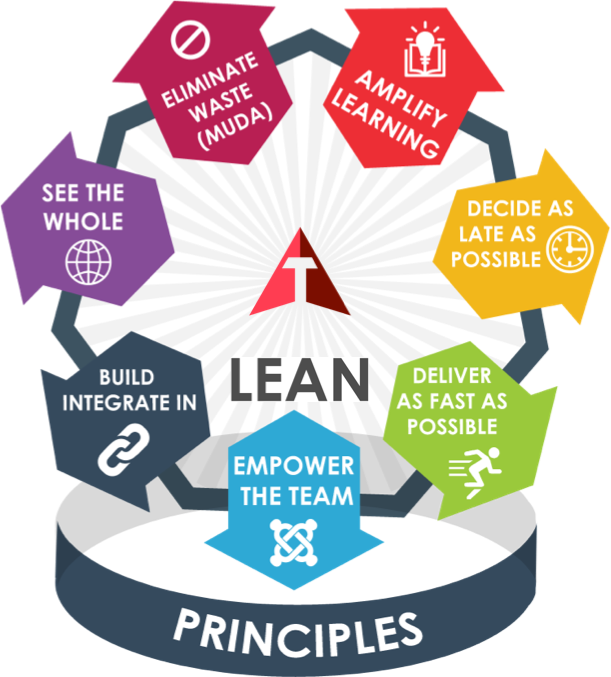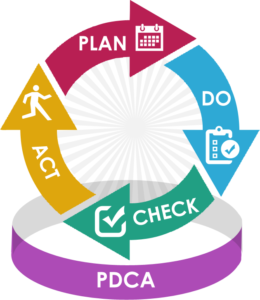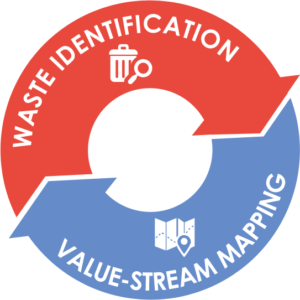Lean – Principles, Practices & Techniques
Mastering Agile Methodologies
- Instructor-led, Online
- Course Category: Agile Development, Change Management
GBP
45
Instructor-led, Online
Duration: 3 hours
Course Code: TXV-MAM-9063
Skill Level: Intermediate
Lean – Principles, Practices & Techniques
Overview
Lean is not mean, at all! From processes to startups, from big businesses to products and even people, lean is in! Having shown its success in manufacturing industry, Lean has stepped into agile development and hasn’t stopped ever since. Lean practices are best known for identifying and removing waste in the processes, activities and products. Value stream mapping and synchronisation are just a few ways in which Lean helps with streamlining the processes in product development. Learn how to implement Lean thinking and working to identify, manage and remove defects in the product development workflows, enrol in TEXAVI’s Lean – Principles, Practices & Techniques course now!

Who can attend?
- Anybody with or without work experience
- IT professionals (eg., Developers, testers) considering a move to BA role
- Non-IT people who want to learn IT skills thinking of a career switch
- Graduates and university students who aspire to get into IT industry
- Students who have just passed their B. Tec, A-Levels or college studies
COURSE OUTLINE
- Overview & setting the context
- LEAN -What, why, when, where
- Key principles in LEAN
- LEAN roles & responsibilities
- Core practices in LEAN
- Reducing waste, the focus of LEAN!
- Key artefacts and deliverables
- DMAIC & other techniques, tools in Lean
- Lean & other agile methods
- Summary – Q & A

What will you learn?
By the end of this course, you will be able to:
- Define what Lean is in the context of agile methodologies
- Explain the origin of Lean in the manufacturing and production setting
- List the core principles in Lean methodology
- Eliminate waste (Muda)
- Amplify learning
- Decide as late as possible
- Deliver as fast as possible
- Empower the team
- Build integrate in
- See the whole

- Describe the journey from Lean production to Lean software development
- Describe the role of Lean in transformation in software development
- List and relate the ten commandments for improvement in Lean:
- Abandon fixed ideas
- Think of ways to make it possible
- No excuses needed
- Go for the simple solution, not the perfect one
- Correct mistakes right away
- Use your wits and not your wallet
- Problems are opportunities
- Repeat WHY? five times
- Seek ideas from many people
- There is no end to improvement

- Provide the rationale for reducing waste (Muda) and increasing value
- Explain the factors contributing to waste in manufacturing and software
- Define the roles and their responsibilities in Lean software development projects
- Describe the key practices in Lean and their relevance to software
- Think of options, wait for the last responsible moment and decide
- Conceptual integrity and perceived integrity
- Importance of refactoring
- Significance of testing and quality assurance, control
- Right measurements in place
- Contracts and their significance
- Explain how continuous improvement is key in Lean
- Plan –> Analyse
- Do –> Implement
- Check –> Evaluate
- Act –> Identify & Act

- Describe the different ways and approaches to reducing waste (Muda)
- Identify the mechanisms of working with different stakeholders
- List and explain the working of different root-cause analysis techniques
- Fishbone diagram/Ishikawa technique
- 5-WHY technique
- 5S’s – Sort, Stabilise, Shine, Standardise, Sustain
- Ask the right questions – What, who, why, when, where and how
- Explain how Lean fits in and works with other agile methodologies
- Describe the various steps in DMAIC tool adopted from Six Sigma framework:
- Define – State the business problem
- Measure – Set the baselines for performance
- Analyse – Go to the root of the problem
- Improve – Identify the steps in solving the problem
- Control – Assess the results/outcomes from implementation
What do you need?
There are no pre-requisites for this course. There is no need for any prior experience, working knowledge or awareness of software development or projects experience. The course is suitable for experienced professionals working in the industry or academia, aspirants and early stage professionals, as well as students in universities and colleges. Professionals and aspirants from technology, business, operations or sales are all welcome to explore and understand the power of Jira and collaborative working.
WHAT'S INCLUDED?
|
 |
Why Texavi?
Learn real-world, practical skills from practising professionals, not just theoritical knowledge from trainers!
-
TEXAVI is a proven leader in delivering non-coding IT learning, worldwide
-
We are not just trainers, but practising IT professionals with 25+ years of work exp
-
Our courses get you job-ready with practical and real-time insights
-
Qualify for certificates upon completion and complete our assessments
-
Pave way for industry-recognised certifications
-
Access to treasure of Texavi’s high-quality, content-rich resources and materials
-
Get discount voucher to our popular courses on Udemy
-
24×7 access to Texavi’s interactive platform with personalised content
Sample Course Video
TEXAVI Tests
Test Your Knowledge

Take the Texavi Tests and challenge yourself, simply click the below links and start the interactive quiz on Lean…
- Quiz on Lean core principles and concepts
- Quiz on Lean software development – Practices & approaches
- Quiz on Agile methods – fundamentals and concepts
Trainer Profile

Your trainer for this course is Pardha Saradhi Mantravadi. Pardha is a seasoned and well-qualified trainer, coach, mentor, influencer and thought leader. He has rich and varied IT-industry experience of 25 years, working in different roles as an IT professional with blue-chip organisations viz., HSBC, Deutsche Bank, Dyson, Asda, Cambridge University Press, Roche, King’s College London , Royal Society of Chemistry etc. Pardha delivers his training sessions by blending the concepts and principles with practical insights from real-life projects and programs…click here to view the complete trainer profile.
Reviews
“The delivery was consistent, thoughtful and measured. Texavi’s masterclass worked well for me.”
– Louise Caldwell, OMT Group
“I enjoyed the bootcamp and found it very inspiring. I found your description of digital transformation very useful and I liked the examples that were given about successful digital businesses.”
– Dr. Carrie Mowatt, Royal Society of Chemistry
“What I like most about Pardha is the way he easily blends empathy for users within day-to-day software development tasks. This mix of vision and execution is rare and powerful.”
– Sarbajit Sen, Steelwedge Software
“Recently Texavi conducted a workshop on Agile methodologies. The trainer’s knowledge on Agile methodology has its roots grounded in experience.”
– Tazeen Sheikh, Mastek
” The trainer is very well-informed. I learnt a lot of background to digital transformation and artificial intelligence and how businesses can use them.”
– Robert Bowles, RSC
“I attended Texavi’s training on Agile Business Analysis and had a lot of takeaways from the session. Pardha’s effective presentation skills supported with context you can relate to, makes the entire experience exhilarating.”
– Abhijeet Majumdar, Zensar Technologies
“The workshop was quite interesting. I found the exercises we did particularly valuable, as it was useful to discuss with the others present, and to then feedback to the wider group.”
– Holly Sheahan, Cambridge Partners
“Excellent speaker, very knowledgeable. Lovely manner and gentle approach.”
– Linda Clifford, Marketing Success
“Texavi has delivered a fantastic product which was above expectations. The ISBE DataHub will support operational and strategic efforts, at the same time reducing the burden of work for staff at KCL.”
– Christine Manoharan, King’s College London
“The workshop was quite interesting, liked the practical and interactive parts. Texavi’s Digital Business Maturity Model is really helpful and necessary for success.”
– Julio C Garcia, Creanto
“The trainer, Pardha is professional yet very friendly, made everyone feel welcome.”
– Chantal Gilbert, BusyBee Consulting
Related Courses
Texavi Toolkit
Team TEXAVI created relevant videos, podcasts, blog posts, white papers, posters and articles for your use. Check the below content out to understand more about Lean agile methodology:
- Don’t fight change, manage it with agility
- Best practices in agile development methodologies (please turn down the volume of the video)
- Testing in agile methodologies – Texavi Poster
- Fostering innovation through interaction and collaboration – Texavi blog post
